University Research Report: Just-Walk Out Technology Methodology
VerifiedAdded on 2021/05/31
|15
|4263
|241
Report
AI Summary
This report outlines the research methodology employed to study Just-Walk Out Technology, focusing on its implementation in retail settings. It begins with an introduction to the technology, highlighting its potential to reduce shopping time and improve customer experience. The research aims to understand market demand, supportive systems, and infrastructure for launching the technology. The study adopts a qualitative research design, employing purposive sampling to gather in-depth insights from customers, retail managers, and billing personnel. The report details the importance of contextual, demographic, perceptual, and theoretical information. It also explains the research design, including the selection of theoretical sampling. The report emphasizes the need for a comprehensive approach to understanding the technology's impact on stakeholders and the existing gaps in the literature concerning its commercial application. The report concludes with a discussion of the research design and its implications.

Running head: RESEARCH METHODOLOGY- JUST-WALK OUT TECHNOLOGY
RESEARCH METHODOLOGY- JUST-WALK OUT TECHNOLOGY
Name of student:
Name of university:
Author note:
RESEARCH METHODOLOGY- JUST-WALK OUT TECHNOLOGY
Name of student:
Name of university:
Author note:
Paraphrase This Document
Need a fresh take? Get an instant paraphrase of this document with our AI Paraphraser
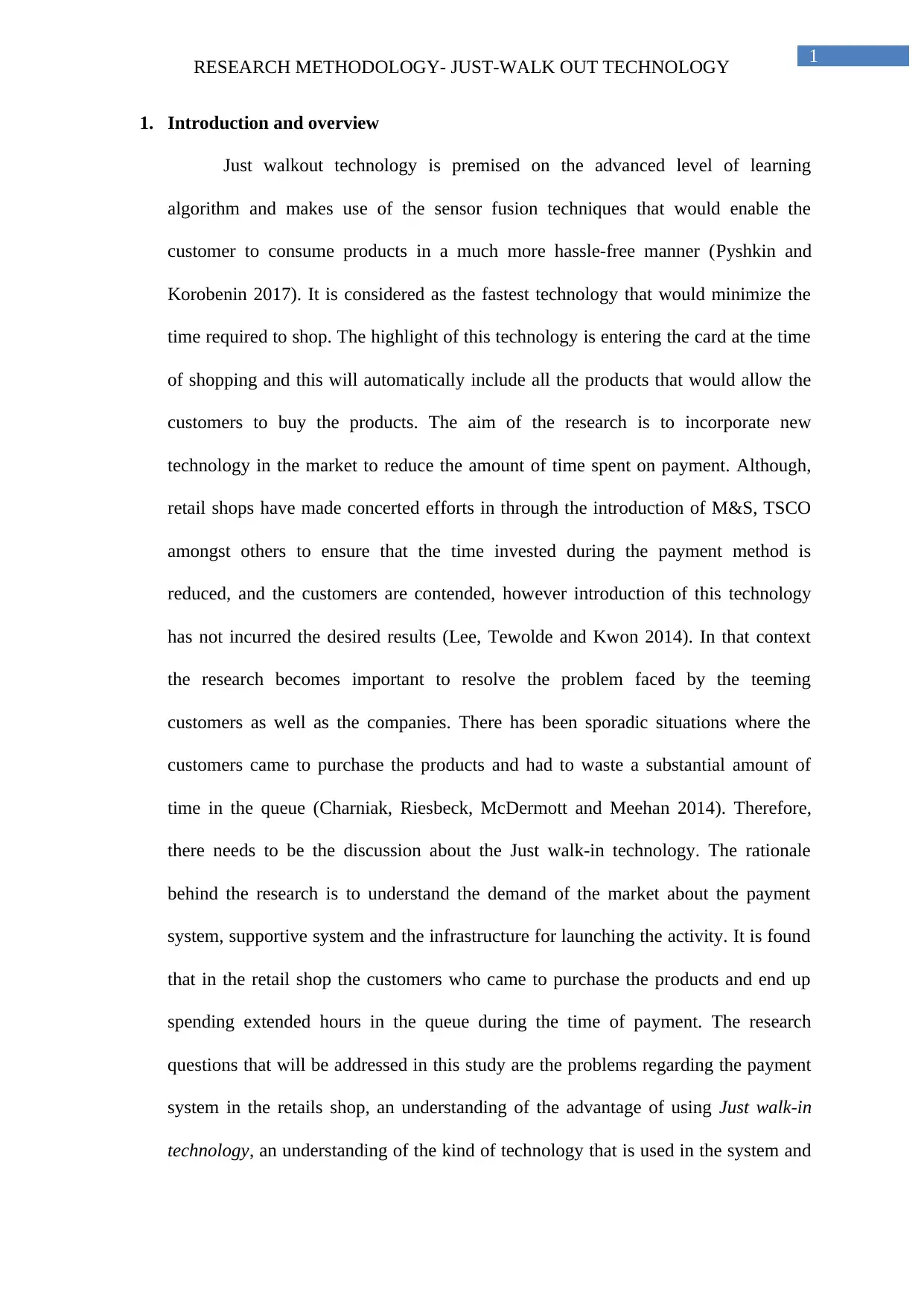
1
RESEARCH METHODOLOGY- JUST-WALK OUT TECHNOLOGY
1. Introduction and overview
Just walkout technology is premised on the advanced level of learning
algorithm and makes use of the sensor fusion techniques that would enable the
customer to consume products in a much more hassle-free manner (Pyshkin and
Korobenin 2017). It is considered as the fastest technology that would minimize the
time required to shop. The highlight of this technology is entering the card at the time
of shopping and this will automatically include all the products that would allow the
customers to buy the products. The aim of the research is to incorporate new
technology in the market to reduce the amount of time spent on payment. Although,
retail shops have made concerted efforts in through the introduction of M&S, TSCO
amongst others to ensure that the time invested during the payment method is
reduced, and the customers are contended, however introduction of this technology
has not incurred the desired results (Lee, Tewolde and Kwon 2014). In that context
the research becomes important to resolve the problem faced by the teeming
customers as well as the companies. There has been sporadic situations where the
customers came to purchase the products and had to waste a substantial amount of
time in the queue (Charniak, Riesbeck, McDermott and Meehan 2014). Therefore,
there needs to be the discussion about the Just walk-in technology. The rationale
behind the research is to understand the demand of the market about the payment
system, supportive system and the infrastructure for launching the activity. It is found
that in the retail shop the customers who came to purchase the products and end up
spending extended hours in the queue during the time of payment. The research
questions that will be addressed in this study are the problems regarding the payment
system in the retails shop, an understanding of the advantage of using Just walk-in
technology, an understanding of the kind of technology that is used in the system and
RESEARCH METHODOLOGY- JUST-WALK OUT TECHNOLOGY
1. Introduction and overview
Just walkout technology is premised on the advanced level of learning
algorithm and makes use of the sensor fusion techniques that would enable the
customer to consume products in a much more hassle-free manner (Pyshkin and
Korobenin 2017). It is considered as the fastest technology that would minimize the
time required to shop. The highlight of this technology is entering the card at the time
of shopping and this will automatically include all the products that would allow the
customers to buy the products. The aim of the research is to incorporate new
technology in the market to reduce the amount of time spent on payment. Although,
retail shops have made concerted efforts in through the introduction of M&S, TSCO
amongst others to ensure that the time invested during the payment method is
reduced, and the customers are contended, however introduction of this technology
has not incurred the desired results (Lee, Tewolde and Kwon 2014). In that context
the research becomes important to resolve the problem faced by the teeming
customers as well as the companies. There has been sporadic situations where the
customers came to purchase the products and had to waste a substantial amount of
time in the queue (Charniak, Riesbeck, McDermott and Meehan 2014). Therefore,
there needs to be the discussion about the Just walk-in technology. The rationale
behind the research is to understand the demand of the market about the payment
system, supportive system and the infrastructure for launching the activity. It is found
that in the retail shop the customers who came to purchase the products and end up
spending extended hours in the queue during the time of payment. The research
questions that will be addressed in this study are the problems regarding the payment
system in the retails shop, an understanding of the advantage of using Just walk-in
technology, an understanding of the kind of technology that is used in the system and
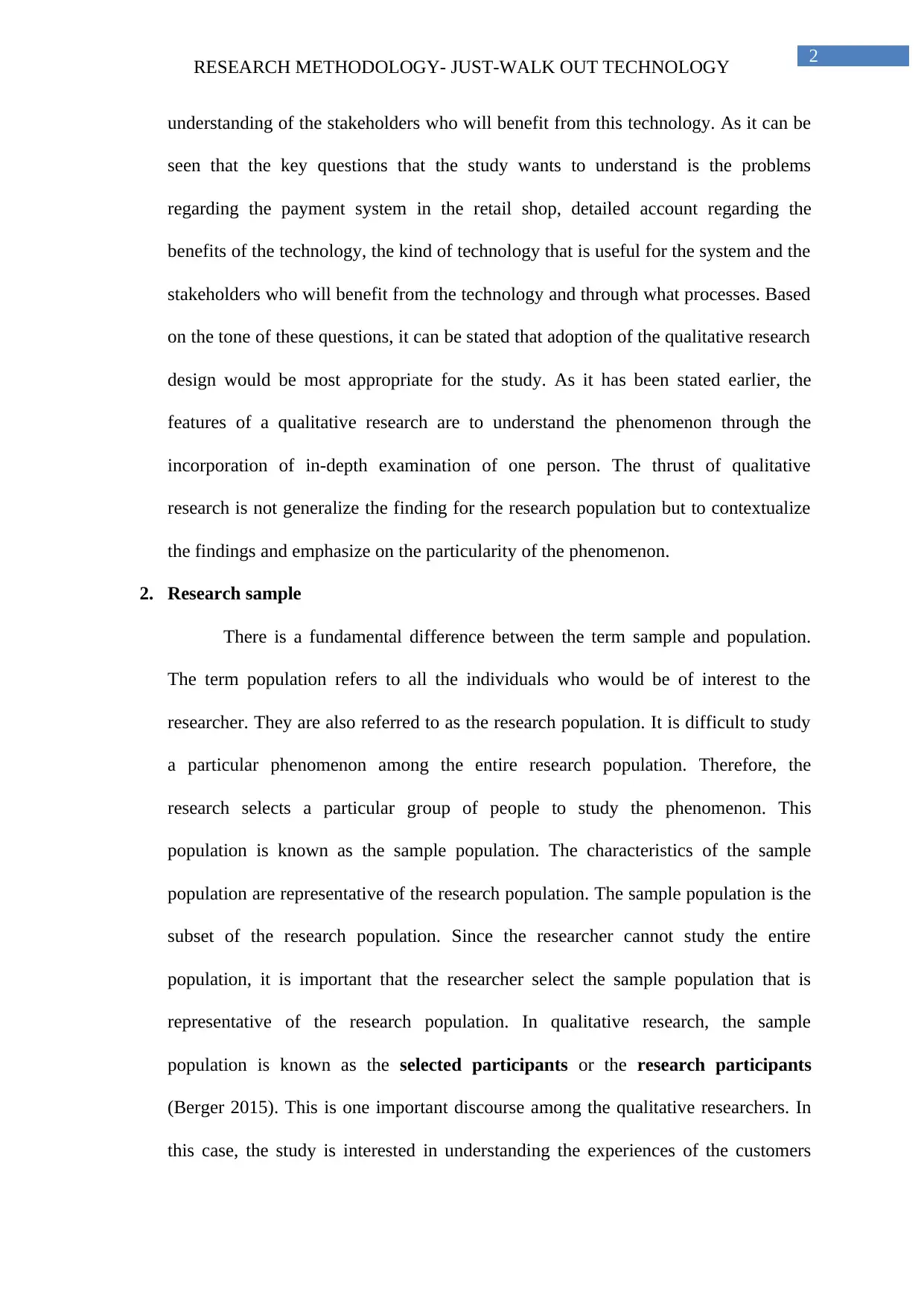
2
RESEARCH METHODOLOGY- JUST-WALK OUT TECHNOLOGY
understanding of the stakeholders who will benefit from this technology. As it can be
seen that the key questions that the study wants to understand is the problems
regarding the payment system in the retail shop, detailed account regarding the
benefits of the technology, the kind of technology that is useful for the system and the
stakeholders who will benefit from the technology and through what processes. Based
on the tone of these questions, it can be stated that adoption of the qualitative research
design would be most appropriate for the study. As it has been stated earlier, the
features of a qualitative research are to understand the phenomenon through the
incorporation of in-depth examination of one person. The thrust of qualitative
research is not generalize the finding for the research population but to contextualize
the findings and emphasize on the particularity of the phenomenon.
2. Research sample
There is a fundamental difference between the term sample and population.
The term population refers to all the individuals who would be of interest to the
researcher. They are also referred to as the research population. It is difficult to study
a particular phenomenon among the entire research population. Therefore, the
research selects a particular group of people to study the phenomenon. This
population is known as the sample population. The characteristics of the sample
population are representative of the research population. The sample population is the
subset of the research population. Since the researcher cannot study the entire
population, it is important that the researcher select the sample population that is
representative of the research population. In qualitative research, the sample
population is known as the selected participants or the research participants
(Berger 2015). This is one important discourse among the qualitative researchers. In
this case, the study is interested in understanding the experiences of the customers
RESEARCH METHODOLOGY- JUST-WALK OUT TECHNOLOGY
understanding of the stakeholders who will benefit from this technology. As it can be
seen that the key questions that the study wants to understand is the problems
regarding the payment system in the retail shop, detailed account regarding the
benefits of the technology, the kind of technology that is useful for the system and the
stakeholders who will benefit from the technology and through what processes. Based
on the tone of these questions, it can be stated that adoption of the qualitative research
design would be most appropriate for the study. As it has been stated earlier, the
features of a qualitative research are to understand the phenomenon through the
incorporation of in-depth examination of one person. The thrust of qualitative
research is not generalize the finding for the research population but to contextualize
the findings and emphasize on the particularity of the phenomenon.
2. Research sample
There is a fundamental difference between the term sample and population.
The term population refers to all the individuals who would be of interest to the
researcher. They are also referred to as the research population. It is difficult to study
a particular phenomenon among the entire research population. Therefore, the
research selects a particular group of people to study the phenomenon. This
population is known as the sample population. The characteristics of the sample
population are representative of the research population. The sample population is the
subset of the research population. Since the researcher cannot study the entire
population, it is important that the researcher select the sample population that is
representative of the research population. In qualitative research, the sample
population is known as the selected participants or the research participants
(Berger 2015). This is one important discourse among the qualitative researchers. In
this case, the study is interested in understanding the experiences of the customers
⊘ This is a preview!⊘
Do you want full access?
Subscribe today to unlock all pages.

Trusted by 1+ million students worldwide
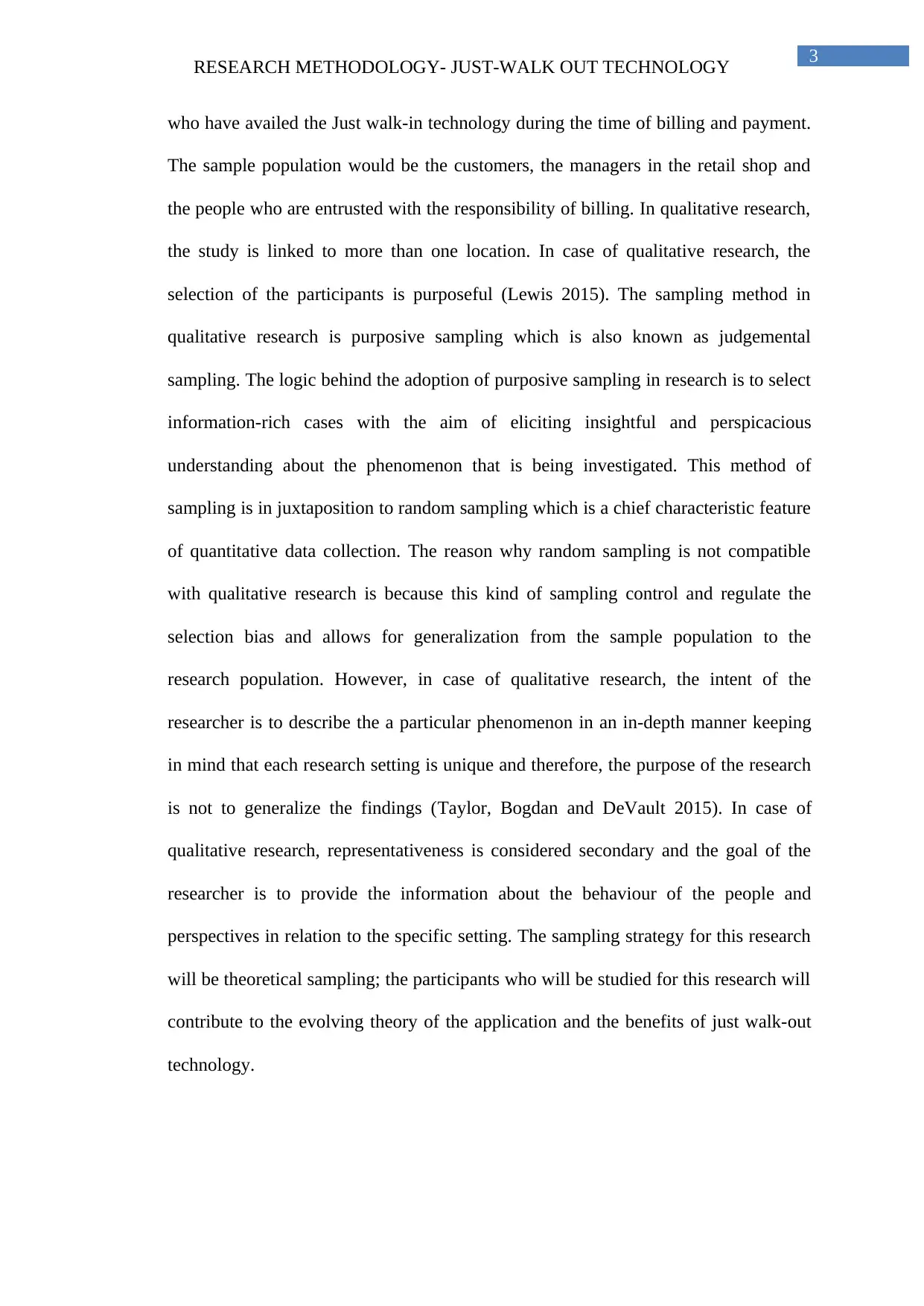
3
RESEARCH METHODOLOGY- JUST-WALK OUT TECHNOLOGY
who have availed the Just walk-in technology during the time of billing and payment.
The sample population would be the customers, the managers in the retail shop and
the people who are entrusted with the responsibility of billing. In qualitative research,
the study is linked to more than one location. In case of qualitative research, the
selection of the participants is purposeful (Lewis 2015). The sampling method in
qualitative research is purposive sampling which is also known as judgemental
sampling. The logic behind the adoption of purposive sampling in research is to select
information-rich cases with the aim of eliciting insightful and perspicacious
understanding about the phenomenon that is being investigated. This method of
sampling is in juxtaposition to random sampling which is a chief characteristic feature
of quantitative data collection. The reason why random sampling is not compatible
with qualitative research is because this kind of sampling control and regulate the
selection bias and allows for generalization from the sample population to the
research population. However, in case of qualitative research, the intent of the
researcher is to describe the a particular phenomenon in an in-depth manner keeping
in mind that each research setting is unique and therefore, the purpose of the research
is not to generalize the findings (Taylor, Bogdan and DeVault 2015). In case of
qualitative research, representativeness is considered secondary and the goal of the
researcher is to provide the information about the behaviour of the people and
perspectives in relation to the specific setting. The sampling strategy for this research
will be theoretical sampling; the participants who will be studied for this research will
contribute to the evolving theory of the application and the benefits of just walk-out
technology.
RESEARCH METHODOLOGY- JUST-WALK OUT TECHNOLOGY
who have availed the Just walk-in technology during the time of billing and payment.
The sample population would be the customers, the managers in the retail shop and
the people who are entrusted with the responsibility of billing. In qualitative research,
the study is linked to more than one location. In case of qualitative research, the
selection of the participants is purposeful (Lewis 2015). The sampling method in
qualitative research is purposive sampling which is also known as judgemental
sampling. The logic behind the adoption of purposive sampling in research is to select
information-rich cases with the aim of eliciting insightful and perspicacious
understanding about the phenomenon that is being investigated. This method of
sampling is in juxtaposition to random sampling which is a chief characteristic feature
of quantitative data collection. The reason why random sampling is not compatible
with qualitative research is because this kind of sampling control and regulate the
selection bias and allows for generalization from the sample population to the
research population. However, in case of qualitative research, the intent of the
researcher is to describe the a particular phenomenon in an in-depth manner keeping
in mind that each research setting is unique and therefore, the purpose of the research
is not to generalize the findings (Taylor, Bogdan and DeVault 2015). In case of
qualitative research, representativeness is considered secondary and the goal of the
researcher is to provide the information about the behaviour of the people and
perspectives in relation to the specific setting. The sampling strategy for this research
will be theoretical sampling; the participants who will be studied for this research will
contribute to the evolving theory of the application and the benefits of just walk-out
technology.
Paraphrase This Document
Need a fresh take? Get an instant paraphrase of this document with our AI Paraphraser
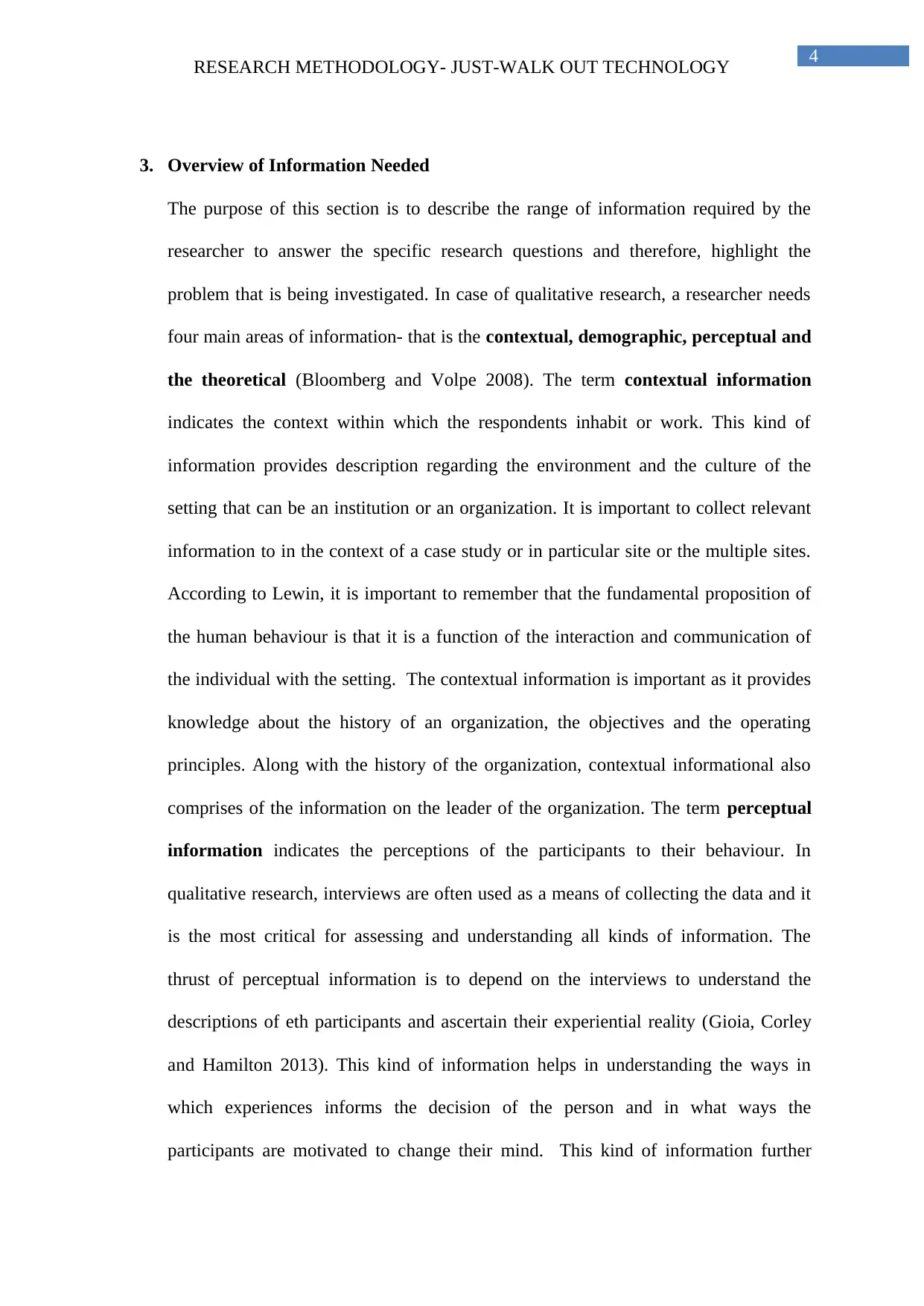
4
RESEARCH METHODOLOGY- JUST-WALK OUT TECHNOLOGY
3. Overview of Information Needed
The purpose of this section is to describe the range of information required by the
researcher to answer the specific research questions and therefore, highlight the
problem that is being investigated. In case of qualitative research, a researcher needs
four main areas of information- that is the contextual, demographic, perceptual and
the theoretical (Bloomberg and Volpe 2008). The term contextual information
indicates the context within which the respondents inhabit or work. This kind of
information provides description regarding the environment and the culture of the
setting that can be an institution or an organization. It is important to collect relevant
information to in the context of a case study or in particular site or the multiple sites.
According to Lewin, it is important to remember that the fundamental proposition of
the human behaviour is that it is a function of the interaction and communication of
the individual with the setting. The contextual information is important as it provides
knowledge about the history of an organization, the objectives and the operating
principles. Along with the history of the organization, contextual informational also
comprises of the information on the leader of the organization. The term perceptual
information indicates the perceptions of the participants to their behaviour. In
qualitative research, interviews are often used as a means of collecting the data and it
is the most critical for assessing and understanding all kinds of information. The
thrust of perceptual information is to depend on the interviews to understand the
descriptions of eth participants and ascertain their experiential reality (Gioia, Corley
and Hamilton 2013). This kind of information helps in understanding the ways in
which experiences informs the decision of the person and in what ways the
participants are motivated to change their mind. This kind of information further
RESEARCH METHODOLOGY- JUST-WALK OUT TECHNOLOGY
3. Overview of Information Needed
The purpose of this section is to describe the range of information required by the
researcher to answer the specific research questions and therefore, highlight the
problem that is being investigated. In case of qualitative research, a researcher needs
four main areas of information- that is the contextual, demographic, perceptual and
the theoretical (Bloomberg and Volpe 2008). The term contextual information
indicates the context within which the respondents inhabit or work. This kind of
information provides description regarding the environment and the culture of the
setting that can be an institution or an organization. It is important to collect relevant
information to in the context of a case study or in particular site or the multiple sites.
According to Lewin, it is important to remember that the fundamental proposition of
the human behaviour is that it is a function of the interaction and communication of
the individual with the setting. The contextual information is important as it provides
knowledge about the history of an organization, the objectives and the operating
principles. Along with the history of the organization, contextual informational also
comprises of the information on the leader of the organization. The term perceptual
information indicates the perceptions of the participants to their behaviour. In
qualitative research, interviews are often used as a means of collecting the data and it
is the most critical for assessing and understanding all kinds of information. The
thrust of perceptual information is to depend on the interviews to understand the
descriptions of eth participants and ascertain their experiential reality (Gioia, Corley
and Hamilton 2013). This kind of information helps in understanding the ways in
which experiences informs the decision of the person and in what ways the
participants are motivated to change their mind. This kind of information further
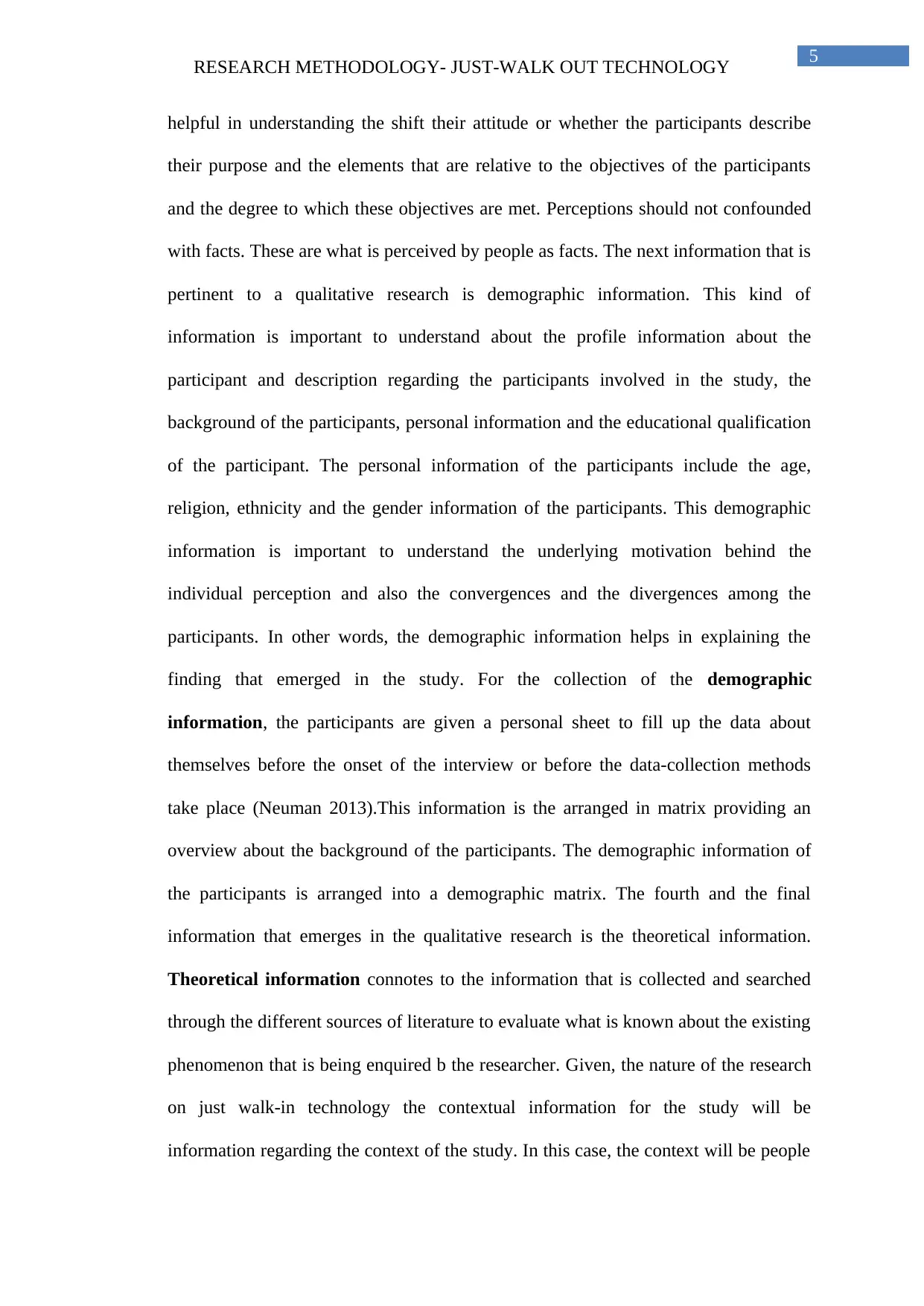
5
RESEARCH METHODOLOGY- JUST-WALK OUT TECHNOLOGY
helpful in understanding the shift their attitude or whether the participants describe
their purpose and the elements that are relative to the objectives of the participants
and the degree to which these objectives are met. Perceptions should not confounded
with facts. These are what is perceived by people as facts. The next information that is
pertinent to a qualitative research is demographic information. This kind of
information is important to understand about the profile information about the
participant and description regarding the participants involved in the study, the
background of the participants, personal information and the educational qualification
of the participant. The personal information of the participants include the age,
religion, ethnicity and the gender information of the participants. This demographic
information is important to understand the underlying motivation behind the
individual perception and also the convergences and the divergences among the
participants. In other words, the demographic information helps in explaining the
finding that emerged in the study. For the collection of the demographic
information, the participants are given a personal sheet to fill up the data about
themselves before the onset of the interview or before the data-collection methods
take place (Neuman 2013).This information is the arranged in matrix providing an
overview about the background of the participants. The demographic information of
the participants is arranged into a demographic matrix. The fourth and the final
information that emerges in the qualitative research is the theoretical information.
Theoretical information connotes to the information that is collected and searched
through the different sources of literature to evaluate what is known about the existing
phenomenon that is being enquired b the researcher. Given, the nature of the research
on just walk-in technology the contextual information for the study will be
information regarding the context of the study. In this case, the context will be people
RESEARCH METHODOLOGY- JUST-WALK OUT TECHNOLOGY
helpful in understanding the shift their attitude or whether the participants describe
their purpose and the elements that are relative to the objectives of the participants
and the degree to which these objectives are met. Perceptions should not confounded
with facts. These are what is perceived by people as facts. The next information that is
pertinent to a qualitative research is demographic information. This kind of
information is important to understand about the profile information about the
participant and description regarding the participants involved in the study, the
background of the participants, personal information and the educational qualification
of the participant. The personal information of the participants include the age,
religion, ethnicity and the gender information of the participants. This demographic
information is important to understand the underlying motivation behind the
individual perception and also the convergences and the divergences among the
participants. In other words, the demographic information helps in explaining the
finding that emerged in the study. For the collection of the demographic
information, the participants are given a personal sheet to fill up the data about
themselves before the onset of the interview or before the data-collection methods
take place (Neuman 2013).This information is the arranged in matrix providing an
overview about the background of the participants. The demographic information of
the participants is arranged into a demographic matrix. The fourth and the final
information that emerges in the qualitative research is the theoretical information.
Theoretical information connotes to the information that is collected and searched
through the different sources of literature to evaluate what is known about the existing
phenomenon that is being enquired b the researcher. Given, the nature of the research
on just walk-in technology the contextual information for the study will be
information regarding the context of the study. In this case, the context will be people
⊘ This is a preview!⊘
Do you want full access?
Subscribe today to unlock all pages.

Trusted by 1+ million students worldwide
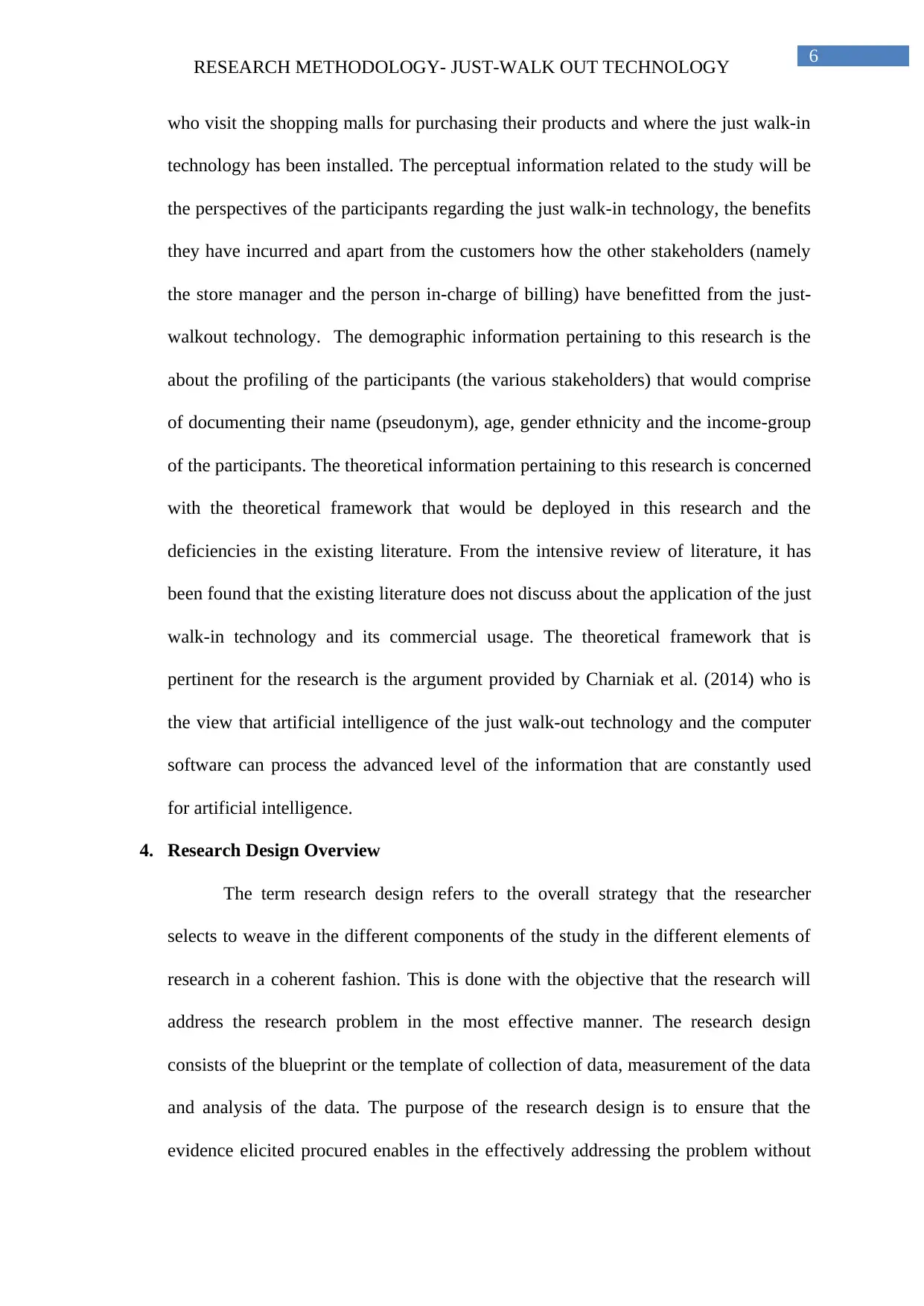
6
RESEARCH METHODOLOGY- JUST-WALK OUT TECHNOLOGY
who visit the shopping malls for purchasing their products and where the just walk-in
technology has been installed. The perceptual information related to the study will be
the perspectives of the participants regarding the just walk-in technology, the benefits
they have incurred and apart from the customers how the other stakeholders (namely
the store manager and the person in-charge of billing) have benefitted from the just-
walkout technology. The demographic information pertaining to this research is the
about the profiling of the participants (the various stakeholders) that would comprise
of documenting their name (pseudonym), age, gender ethnicity and the income-group
of the participants. The theoretical information pertaining to this research is concerned
with the theoretical framework that would be deployed in this research and the
deficiencies in the existing literature. From the intensive review of literature, it has
been found that the existing literature does not discuss about the application of the just
walk-in technology and its commercial usage. The theoretical framework that is
pertinent for the research is the argument provided by Charniak et al. (2014) who is
the view that artificial intelligence of the just walk-out technology and the computer
software can process the advanced level of the information that are constantly used
for artificial intelligence.
4. Research Design Overview
The term research design refers to the overall strategy that the researcher
selects to weave in the different components of the study in the different elements of
research in a coherent fashion. This is done with the objective that the research will
address the research problem in the most effective manner. The research design
consists of the blueprint or the template of collection of data, measurement of the data
and analysis of the data. The purpose of the research design is to ensure that the
evidence elicited procured enables in the effectively addressing the problem without
RESEARCH METHODOLOGY- JUST-WALK OUT TECHNOLOGY
who visit the shopping malls for purchasing their products and where the just walk-in
technology has been installed. The perceptual information related to the study will be
the perspectives of the participants regarding the just walk-in technology, the benefits
they have incurred and apart from the customers how the other stakeholders (namely
the store manager and the person in-charge of billing) have benefitted from the just-
walkout technology. The demographic information pertaining to this research is the
about the profiling of the participants (the various stakeholders) that would comprise
of documenting their name (pseudonym), age, gender ethnicity and the income-group
of the participants. The theoretical information pertaining to this research is concerned
with the theoretical framework that would be deployed in this research and the
deficiencies in the existing literature. From the intensive review of literature, it has
been found that the existing literature does not discuss about the application of the just
walk-in technology and its commercial usage. The theoretical framework that is
pertinent for the research is the argument provided by Charniak et al. (2014) who is
the view that artificial intelligence of the just walk-out technology and the computer
software can process the advanced level of the information that are constantly used
for artificial intelligence.
4. Research Design Overview
The term research design refers to the overall strategy that the researcher
selects to weave in the different components of the study in the different elements of
research in a coherent fashion. This is done with the objective that the research will
address the research problem in the most effective manner. The research design
consists of the blueprint or the template of collection of data, measurement of the data
and analysis of the data. The purpose of the research design is to ensure that the
evidence elicited procured enables in the effectively addressing the problem without
Paraphrase This Document
Need a fresh take? Get an instant paraphrase of this document with our AI Paraphraser
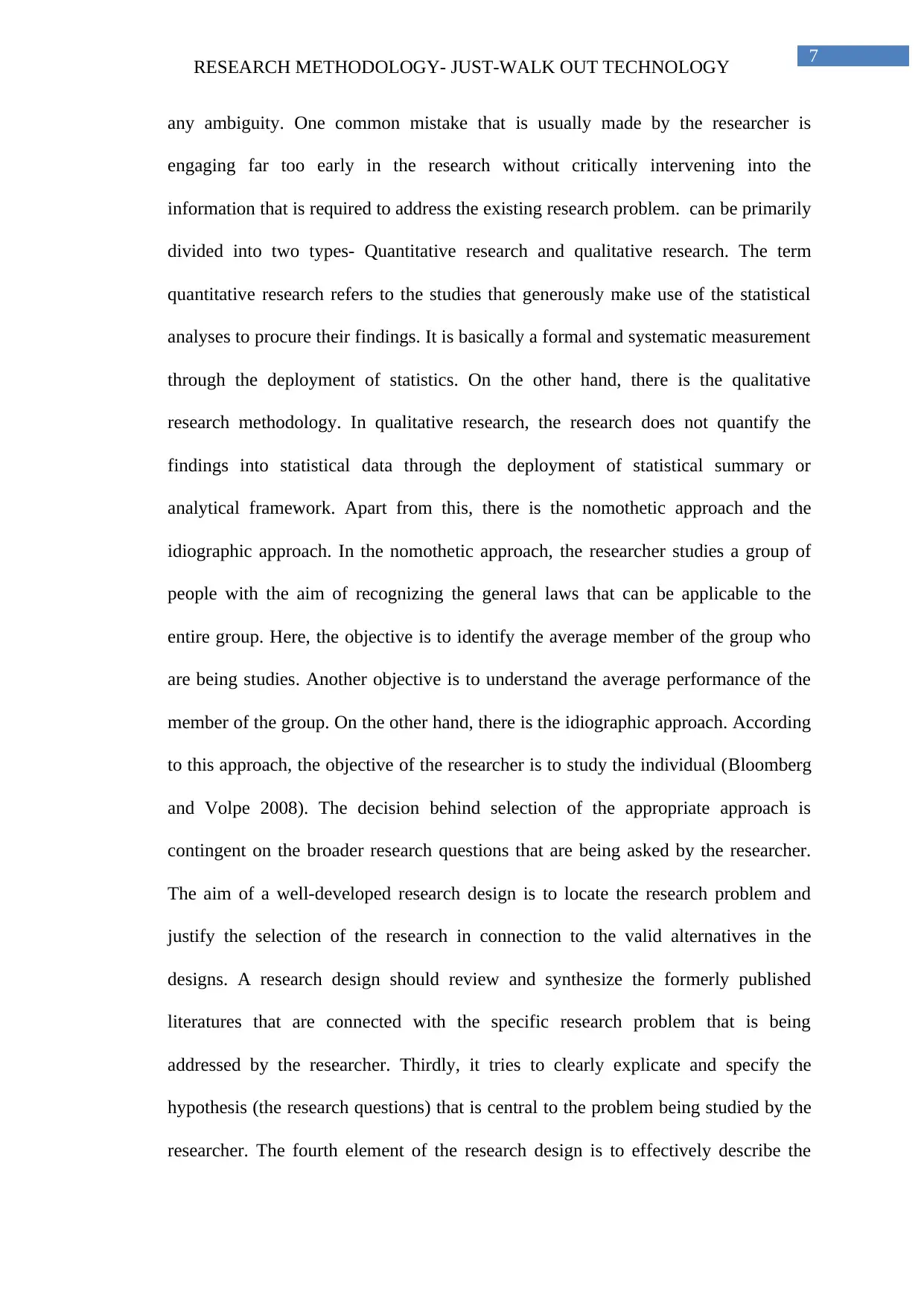
7
RESEARCH METHODOLOGY- JUST-WALK OUT TECHNOLOGY
any ambiguity. One common mistake that is usually made by the researcher is
engaging far too early in the research without critically intervening into the
information that is required to address the existing research problem. can be primarily
divided into two types- Quantitative research and qualitative research. The term
quantitative research refers to the studies that generously make use of the statistical
analyses to procure their findings. It is basically a formal and systematic measurement
through the deployment of statistics. On the other hand, there is the qualitative
research methodology. In qualitative research, the research does not quantify the
findings into statistical data through the deployment of statistical summary or
analytical framework. Apart from this, there is the nomothetic approach and the
idiographic approach. In the nomothetic approach, the researcher studies a group of
people with the aim of recognizing the general laws that can be applicable to the
entire group. Here, the objective is to identify the average member of the group who
are being studies. Another objective is to understand the average performance of the
member of the group. On the other hand, there is the idiographic approach. According
to this approach, the objective of the researcher is to study the individual (Bloomberg
and Volpe 2008). The decision behind selection of the appropriate approach is
contingent on the broader research questions that are being asked by the researcher.
The aim of a well-developed research design is to locate the research problem and
justify the selection of the research in connection to the valid alternatives in the
designs. A research design should review and synthesize the formerly published
literatures that are connected with the specific research problem that is being
addressed by the researcher. Thirdly, it tries to clearly explicate and specify the
hypothesis (the research questions) that is central to the problem being studied by the
researcher. The fourth element of the research design is to effectively describe the
RESEARCH METHODOLOGY- JUST-WALK OUT TECHNOLOGY
any ambiguity. One common mistake that is usually made by the researcher is
engaging far too early in the research without critically intervening into the
information that is required to address the existing research problem. can be primarily
divided into two types- Quantitative research and qualitative research. The term
quantitative research refers to the studies that generously make use of the statistical
analyses to procure their findings. It is basically a formal and systematic measurement
through the deployment of statistics. On the other hand, there is the qualitative
research methodology. In qualitative research, the research does not quantify the
findings into statistical data through the deployment of statistical summary or
analytical framework. Apart from this, there is the nomothetic approach and the
idiographic approach. In the nomothetic approach, the researcher studies a group of
people with the aim of recognizing the general laws that can be applicable to the
entire group. Here, the objective is to identify the average member of the group who
are being studies. Another objective is to understand the average performance of the
member of the group. On the other hand, there is the idiographic approach. According
to this approach, the objective of the researcher is to study the individual (Bloomberg
and Volpe 2008). The decision behind selection of the appropriate approach is
contingent on the broader research questions that are being asked by the researcher.
The aim of a well-developed research design is to locate the research problem and
justify the selection of the research in connection to the valid alternatives in the
designs. A research design should review and synthesize the formerly published
literatures that are connected with the specific research problem that is being
addressed by the researcher. Thirdly, it tries to clearly explicate and specify the
hypothesis (the research questions) that is central to the problem being studied by the
researcher. The fourth element of the research design is to effectively describe the
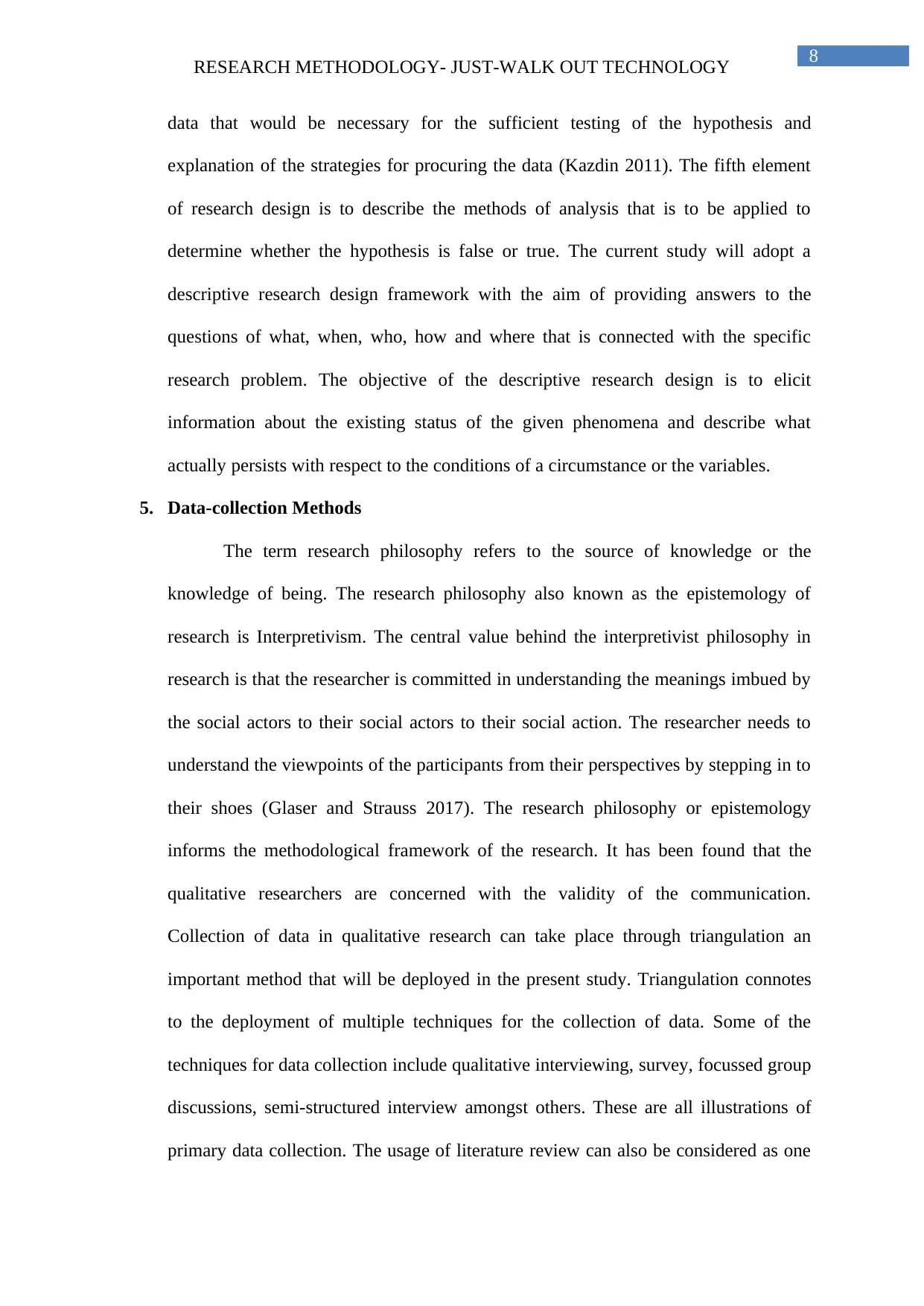
8
RESEARCH METHODOLOGY- JUST-WALK OUT TECHNOLOGY
data that would be necessary for the sufficient testing of the hypothesis and
explanation of the strategies for procuring the data (Kazdin 2011). The fifth element
of research design is to describe the methods of analysis that is to be applied to
determine whether the hypothesis is false or true. The current study will adopt a
descriptive research design framework with the aim of providing answers to the
questions of what, when, who, how and where that is connected with the specific
research problem. The objective of the descriptive research design is to elicit
information about the existing status of the given phenomena and describe what
actually persists with respect to the conditions of a circumstance or the variables.
5. Data-collection Methods
The term research philosophy refers to the source of knowledge or the
knowledge of being. The research philosophy also known as the epistemology of
research is Interpretivism. The central value behind the interpretivist philosophy in
research is that the researcher is committed in understanding the meanings imbued by
the social actors to their social actors to their social action. The researcher needs to
understand the viewpoints of the participants from their perspectives by stepping in to
their shoes (Glaser and Strauss 2017). The research philosophy or epistemology
informs the methodological framework of the research. It has been found that the
qualitative researchers are concerned with the validity of the communication.
Collection of data in qualitative research can take place through triangulation an
important method that will be deployed in the present study. Triangulation connotes
to the deployment of multiple techniques for the collection of data. Some of the
techniques for data collection include qualitative interviewing, survey, focussed group
discussions, semi-structured interview amongst others. These are all illustrations of
primary data collection. The usage of literature review can also be considered as one
RESEARCH METHODOLOGY- JUST-WALK OUT TECHNOLOGY
data that would be necessary for the sufficient testing of the hypothesis and
explanation of the strategies for procuring the data (Kazdin 2011). The fifth element
of research design is to describe the methods of analysis that is to be applied to
determine whether the hypothesis is false or true. The current study will adopt a
descriptive research design framework with the aim of providing answers to the
questions of what, when, who, how and where that is connected with the specific
research problem. The objective of the descriptive research design is to elicit
information about the existing status of the given phenomena and describe what
actually persists with respect to the conditions of a circumstance or the variables.
5. Data-collection Methods
The term research philosophy refers to the source of knowledge or the
knowledge of being. The research philosophy also known as the epistemology of
research is Interpretivism. The central value behind the interpretivist philosophy in
research is that the researcher is committed in understanding the meanings imbued by
the social actors to their social actors to their social action. The researcher needs to
understand the viewpoints of the participants from their perspectives by stepping in to
their shoes (Glaser and Strauss 2017). The research philosophy or epistemology
informs the methodological framework of the research. It has been found that the
qualitative researchers are concerned with the validity of the communication.
Collection of data in qualitative research can take place through triangulation an
important method that will be deployed in the present study. Triangulation connotes
to the deployment of multiple techniques for the collection of data. Some of the
techniques for data collection include qualitative interviewing, survey, focussed group
discussions, semi-structured interview amongst others. These are all illustrations of
primary data collection. The usage of literature review can also be considered as one
⊘ This is a preview!⊘
Do you want full access?
Subscribe today to unlock all pages.

Trusted by 1+ million students worldwide

9
RESEARCH METHODOLOGY- JUST-WALK OUT TECHNOLOGY
of the methods for the collection of data (this is known as the secondary method of
data collection). Therefore, data collection is of two types-primary data collection and
secondary data collection. In relation to this research there will be the incorporation of
both primary and secondary data collection instruments. Survey and questionnaire
that are otherwise known as part of the quantitative research will be deployed in this
study (Taylor, Bogdan and DeVault 2015). A survey will conducted among the
customers who have visited the retail shop that have just walk-out technology and
also retails hops that have other forms of technology. Conducting this survey will be
understanding the advantages and disadvantages faced by the customers whilst using
both these technologies during the time of payment along with that the everyday
challenges and ordeals faced by the customers during the time of payment in the
retails shops. A survey will also conducted among the store managers of the retail
shops and the person in-charge of the billing section to understand their views about
the rate of customer satisfaction that can be measured through the incorporation of the
ordinal scale in the questionnaire, increase in the number of customers after the
incorporation of just walk-out technology, whether they have received complaints
from the customers due to the amount of time taken during the billing or whether they
had installed any other technology prior to the installation of the just walk-out
technology. Interviews will be conducted with the store managers and the customers
to understand about the incorporation of artificial intelligence in the payment
procedure. The demographic profiling of the customers will enable in understanding
the composition of the customers who visit these retail shops. A case study will be
conducted on two retail shops one with just walk-out technology and another retails
shop that has a different kind of technology during the time of payment. This will
provide a comparative analysis through an intensive study into the organization.
RESEARCH METHODOLOGY- JUST-WALK OUT TECHNOLOGY
of the methods for the collection of data (this is known as the secondary method of
data collection). Therefore, data collection is of two types-primary data collection and
secondary data collection. In relation to this research there will be the incorporation of
both primary and secondary data collection instruments. Survey and questionnaire
that are otherwise known as part of the quantitative research will be deployed in this
study (Taylor, Bogdan and DeVault 2015). A survey will conducted among the
customers who have visited the retail shop that have just walk-out technology and
also retails hops that have other forms of technology. Conducting this survey will be
understanding the advantages and disadvantages faced by the customers whilst using
both these technologies during the time of payment along with that the everyday
challenges and ordeals faced by the customers during the time of payment in the
retails shops. A survey will also conducted among the store managers of the retail
shops and the person in-charge of the billing section to understand their views about
the rate of customer satisfaction that can be measured through the incorporation of the
ordinal scale in the questionnaire, increase in the number of customers after the
incorporation of just walk-out technology, whether they have received complaints
from the customers due to the amount of time taken during the billing or whether they
had installed any other technology prior to the installation of the just walk-out
technology. Interviews will be conducted with the store managers and the customers
to understand about the incorporation of artificial intelligence in the payment
procedure. The demographic profiling of the customers will enable in understanding
the composition of the customers who visit these retail shops. A case study will be
conducted on two retail shops one with just walk-out technology and another retails
shop that has a different kind of technology during the time of payment. This will
provide a comparative analysis through an intensive study into the organization.
Paraphrase This Document
Need a fresh take? Get an instant paraphrase of this document with our AI Paraphraser

10
RESEARCH METHODOLOGY- JUST-WALK OUT TECHNOLOGY
6. Data Analysis and Synthesis
The data analysis process commences with putting the plan into action by
learning how to manage and organize the large volume of data that is obtained
through the fieldwork. This process is completed through the identification of the
patterns of the data collected and thereby organizing them into chapters through
transcription of the data following the appropriate theoretical framework. The
conceptual framework that was revealed during the review of literature becomes
pertinent during this stage. The raw data in this stage will be categorized into the
different themes that have emerged through the review of literature needs to be
categorized within the given conceptual framework. In this case, the incorporation of
artificial intelligence and automatic shopping will be the conceptual framework within
which the raw data will be organized (Creswell and Creswell 2017). Open coding will
be adopted for this research as it leads to the refinement of the data that is later
arranged into the final coding schema. The process of data analysis in qualitative
research will be both inductive as well deductive. The deductive section of the
research will be obtained from the review of literature, whereas the inductive section
of the research will be done through the primary data collection. A pilot study will be
conducted to test the validity of the research instrument in this case the questionnaire
and the interview schedule. Based on the pilot study, the questions in the
questionnaire and the interview schedule will be modified and restructured to suit the
purpose of the research. There may be discrepancies in the findings with that of the
literature review that may be resolved through discussion and reconciliation. The
discrepancies that will emerge will be used in further exploration to refine the
condition of the findings of the data, analysis and for future recommendations. In case
RESEARCH METHODOLOGY- JUST-WALK OUT TECHNOLOGY
6. Data Analysis and Synthesis
The data analysis process commences with putting the plan into action by
learning how to manage and organize the large volume of data that is obtained
through the fieldwork. This process is completed through the identification of the
patterns of the data collected and thereby organizing them into chapters through
transcription of the data following the appropriate theoretical framework. The
conceptual framework that was revealed during the review of literature becomes
pertinent during this stage. The raw data in this stage will be categorized into the
different themes that have emerged through the review of literature needs to be
categorized within the given conceptual framework. In this case, the incorporation of
artificial intelligence and automatic shopping will be the conceptual framework within
which the raw data will be organized (Creswell and Creswell 2017). Open coding will
be adopted for this research as it leads to the refinement of the data that is later
arranged into the final coding schema. The process of data analysis in qualitative
research will be both inductive as well deductive. The deductive section of the
research will be obtained from the review of literature, whereas the inductive section
of the research will be done through the primary data collection. A pilot study will be
conducted to test the validity of the research instrument in this case the questionnaire
and the interview schedule. Based on the pilot study, the questions in the
questionnaire and the interview schedule will be modified and restructured to suit the
purpose of the research. There may be discrepancies in the findings with that of the
literature review that may be resolved through discussion and reconciliation. The
discrepancies that will emerge will be used in further exploration to refine the
condition of the findings of the data, analysis and for future recommendations. In case
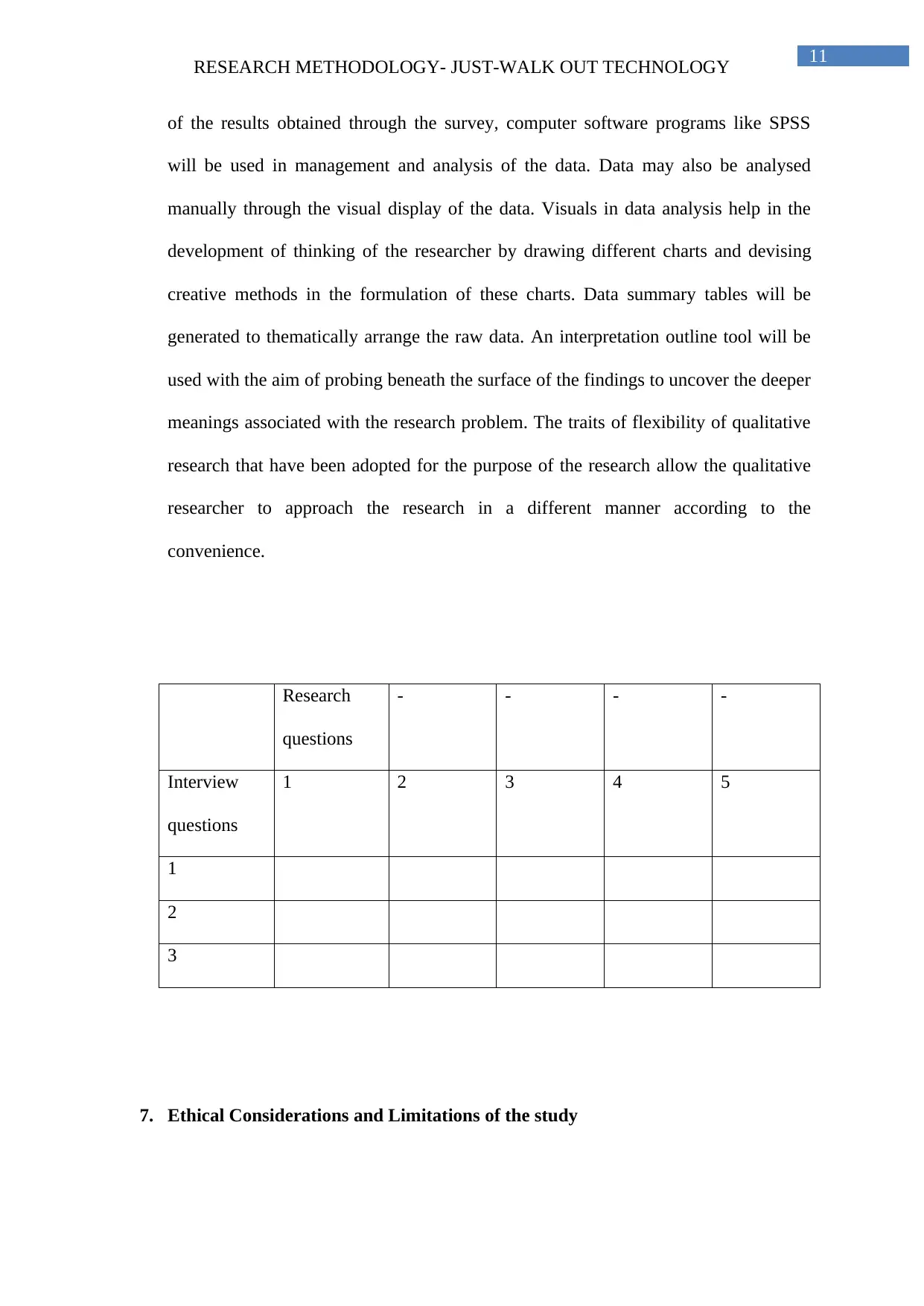
11
RESEARCH METHODOLOGY- JUST-WALK OUT TECHNOLOGY
of the results obtained through the survey, computer software programs like SPSS
will be used in management and analysis of the data. Data may also be analysed
manually through the visual display of the data. Visuals in data analysis help in the
development of thinking of the researcher by drawing different charts and devising
creative methods in the formulation of these charts. Data summary tables will be
generated to thematically arrange the raw data. An interpretation outline tool will be
used with the aim of probing beneath the surface of the findings to uncover the deeper
meanings associated with the research problem. The traits of flexibility of qualitative
research that have been adopted for the purpose of the research allow the qualitative
researcher to approach the research in a different manner according to the
convenience.
Research
questions
- - - -
Interview
questions
1 2 3 4 5
1
2
3
7. Ethical Considerations and Limitations of the study
RESEARCH METHODOLOGY- JUST-WALK OUT TECHNOLOGY
of the results obtained through the survey, computer software programs like SPSS
will be used in management and analysis of the data. Data may also be analysed
manually through the visual display of the data. Visuals in data analysis help in the
development of thinking of the researcher by drawing different charts and devising
creative methods in the formulation of these charts. Data summary tables will be
generated to thematically arrange the raw data. An interpretation outline tool will be
used with the aim of probing beneath the surface of the findings to uncover the deeper
meanings associated with the research problem. The traits of flexibility of qualitative
research that have been adopted for the purpose of the research allow the qualitative
researcher to approach the research in a different manner according to the
convenience.
Research
questions
- - - -
Interview
questions
1 2 3 4 5
1
2
3
7. Ethical Considerations and Limitations of the study
⊘ This is a preview!⊘
Do you want full access?
Subscribe today to unlock all pages.

Trusted by 1+ million students worldwide
1 out of 15
Related Documents
Your All-in-One AI-Powered Toolkit for Academic Success.
+13062052269
info@desklib.com
Available 24*7 on WhatsApp / Email
![[object Object]](/_next/static/media/star-bottom.7253800d.svg)
Unlock your academic potential
Copyright © 2020–2025 A2Z Services. All Rights Reserved. Developed and managed by ZUCOL.





